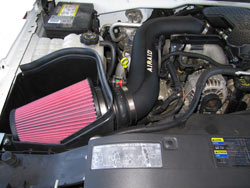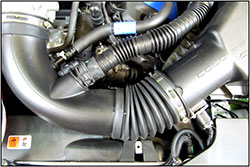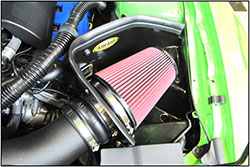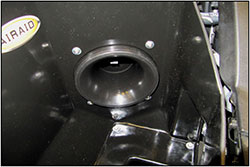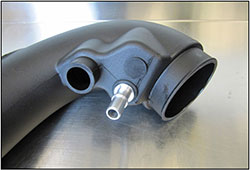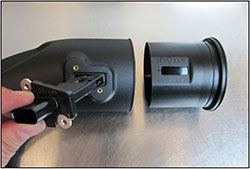Do Cold Air Intakes Really Work?
- May 10, 2016
Cold air intake systems have been around for many years, and they have long been proven to increase vehicle power and performance. Cold air intakes have been the subject of countless magazine articles, television show segments, and independent tests, where in nearly all cases the intake systems manufactured by reputable companies like AIRAID have shown an increase in power. But how? Is it really as easy as slapping a racy-looking cone filter on the end of a tube? The answer is no, but it’s always a good idea to understand why a product works when shopping for upgrades to your own vehicle. Therefore, let’s take a closer look at exactly how cold air intake systems work. It’s important to understand two basic things when discussing cold air intakes. First, cold air is denser than warm air, meaning cold air packs more oxygen molecules into an engine than hot air. More oxygen leads to more complete combustion, which equates to additional power and efficiency. Secondly, an engine is essentially a big air pump. It draws in air to mix with fuel, ignites the mixture, and expels the spent air mixture out of the exhaust. In an ideal world, the engine would be able to inhale as much air as it needed and exhale it with no restrictions to airflow either coming in or going out. The problem in the real world, however, is that the process of an engine drawing in air and expelling burned exhaust gases is very noisy. Anyone that has driven a vehicle with a broken exhaust system or been near an engine that is running with the intake system disconnected can understand just how loud an engine can be. Further, there needs to be some way to filter incoming air from dirt and debris because dirt will damage engine internals. To cut down on the noise, OEM manufacturers place various baffles and mufflers on both the intake side of the engine and the exhaust, and they also add some type of filter to the inlet in order to protect the engine from foreign particles. The issue is that these baffles and mufflers seriously restrict the engine’s ability to inhale clean air and expel exhaust gasses. OEMs usually place a higher priority on noise reduction than engine efficiency. Factory designs often hamper engine performance further by placing the engine inlet duct in an area where it is exposed to hot engine compartment air rather than routing it to an area where the engine can draw in cool outside air. The end result is an engine that doesn’t run as efficiently or make as much power as it potentially could. Things like shrouded air boxes, undersized air filters, strategically placed baffles in the intake tubes, and inlet tracts routed near engine heat all restrict airflow and therefore hurt power and performance. AIRAID cold air intake systems (and those from other reputable intake manufacturers) work by targeting the most restrictive portions of a typical stock intake system: the air box, the intake tube, and the air filter. They also place a priority on getting cool, outside air directly to the engine. Typical AIRAID Intakes replace all or a portion of the factory air box, which is where restrictions most often lie. By opening up the air box, the engine is able to draw in more cool outside air. The intake systems keep the air filter isolated from hot engine compartment air, make use of any factory cold air inlet duct present, and also add additional forward-facing areas for cold outside air to be drawn into the filter. A new intake tube often replaces the factory tube that is typically full of baffles and corrugations, and these replacement intake tubes further optimize airflow to the engine. The AIRAID intake tubes have provisions for any factory breathers and sensors, and ensure that mass air flow (MAF) sensors (when present) are in a position to work properly with the factory calibration. In the vast majority of cases, AIRAID intake systems do not require an aftermarket tune. To top it all off, AIRAID uses a large premium filter to keep the engine supplied with plenty of cool air without sacrificing filtration. AIRAID purposely increases the size of the filters used with an intake, which increases the surface area of the filter media. The larger the surface area, the greater the volume of air that a filter can pass while trapping harmful particulates. More surface area also means that a filter can go longer between cleanings, which is why recommended service intervals for an AIRAID premium filter are often longer than a stock paper filter. Though the principles of how cold air intakes work are fairly simple, the execution is pretty complicated. Air box and intake tube designs must increase airflow to the engine without creating additional turbulence, and the placement of certain sensors in the airflow path is critical. As modern engines and their management systems get more complex, they also become more sensitive to changes from the factory configuration. It is for these reasons that there are many hours in design and development work that go into each and every AIRAID intake. The newest AIRAID intake systems are designed using the latest computer modeling software, and sophisticated tools like flow benches and 3D printers to ensure a premium, well-fitting intake system. Further, each application is subject to countless hours of dyno testing and real-world driving conditions to ensure that every intake performs as it should without introducing any problems or “check engine” lights. Today’s vehicles often have more computing power than the typical home computer, so the days of simply sticking a filter on the end of a tube are long gone. By applying these and other tricks of the trade, AIRAID cold air intakes allow the engine to draw in more outside air, which in turn leads to more complete combustion and results in more power and acceleration. To view all the AIRAID performance products for any vehicle, use the AIRAID Product Search by Vehicle tool. Also you can find a local AIRAID retailer by plugging your location into the AIRAID Dealer Search as well. |
|||
|
|||

